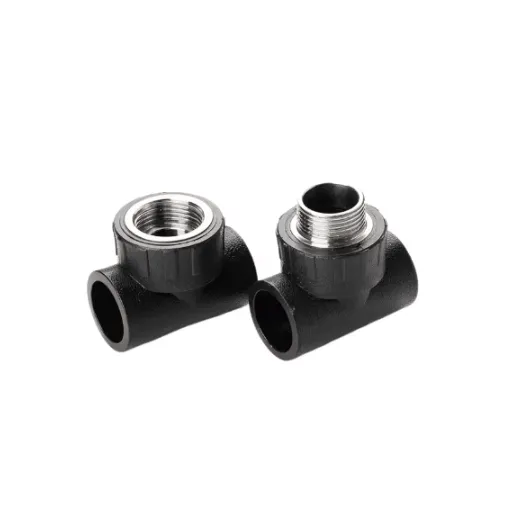Stiff and rigid polyethylene pipes had been generally into HDPE treats until a time when the “pipe obsession” took hold. Unfortunately, the success depended on the quality and functionality of the fittings. Among those, HDPE socket male coupler retains a position of importance in the pipe fusion process to ensure a reliable and leak-free joint for various industrial and commercial uses. The article takes up a study of the working, design, and benefits of the HDPE Socket Male Coupler to give an extensive view of the fundamental nature of this fitting in the world of polyethylene piping. So, whether you are a technician dealing with large-scale projects or managing smaller installations, this will give you a good understanding of how this fitting works for optimum system performance.
Introduction to HDPE Socket Male Couplers
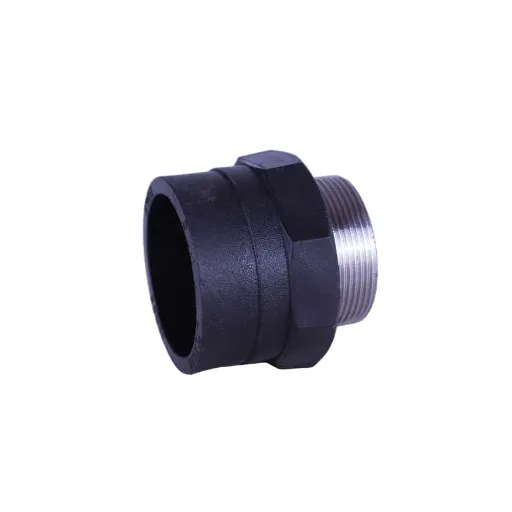
What is an HDPE Socket Male Coupler?
An HDPE socket male coupler is a special pipe fitting that serves to firmly and securely connect HDPE pipes. The male thread end fits perfectly with a female thread of a matching genuine component for a lock-tight, leak-proof fit. The socket end design easily fits in the HDPE pipe for a firm bond when installed correctly.
These fittings find great use in water distribution, gas pipeline, irrigation, and industrial fluid contracting, etc. Such HDPE Socket Male Couplers are great for their fortification against abrasion and chemical effects, and also against maximum temperature fluctuation. Hence, for carrying either high pressures or low pressures, any piping system considers it a reliable friend.
Besides, this particular material constitution of HDPE offers inherent flexibility and toughness; thus, it would not crack or deform under pressure. Hence, by using HDPE Socket Male Couplers in the piping system, the installers will boost the overall efficiency and reliability of the network, guaranteed to work long hours with little maintenance, which is vital for critical operations.
Importance of HDPE in Pipe Fitting
Durability, versatility, and cost-effectiveness make high-density polyethylene one of the main selections in pipe fitting applications. Being resistant to corrosion, rust, and chemical exposure, it is useful for processes such as water distribution, gas pipelines, and handling industrial fluids. Contrary to some traditional metallic materials, HDPE will not wear out simply by exposure to nature and harsh conditions; hence, it offers a long life service for the piping works.
Another very important feature HDPE provides is being lightweight while being able to sustain a much higher load during transportation and installation than any other product. This ensures reduced labor cost and time for installation while not compromising network reliability. It is quite flexible, a very important property when working in uneven terrain or areas where there is a chance of ground movement, thereby reducing the chances of cracking or joint failures to a great extent.
Its ability to allow heat-fusion welding also means the joints will be highly leak-resistant, thereby increasing the efficiency of the entire network. Such a technique creates a seamless and permanent joint connection that far surpasses traditional jointing systems for ease of life and maintenance level. HDPE pipe fittings are, therefore, generally accepted as a perfect solution for infrastructure projects requiring reliable, low-maintenance, and long-life performance.
Applications of HDPE Socket Couplers
HDPE socket couplers are flexible fittings required in many high-performance applications of the modern infrastructure. Corrosion-resistant, pressure-bearing, and easy to install, the socket couplers find their application in various industries. As for their uses, below are some of the applications along with their descriptions:
Potable Water Distribution
HDPE socket couplers find use in potable water distribution systems, as the connections are leak-proof and the material is safe and non-toxic. They allow clean water to be supplied efficiently, with little maintenance and no possibility of contamination, making them suitable for an urban and rural water supply network.
Gas Pipeline Systems
These couplers serve as a medium of transmission for gaseous substances, wherein utmost attention is given to safety and reliability. HDPE socket couplers allow the escape of high pressure, which occurs during sealing; here, a sealant is created against leaks, along with accommodation for the uninterrupted flow of gas and fewer chances of potential hazards.
Wastewater and Sewage Management
HDPE socket couplers are fitted in wastewater and sewage pipelines, resisting chemical and abrasive wear. They provide sturdy and efficient systems to handle corrosive waste materials with little or no maintenance.
Irrigation Systems
Agricultural irrigation systems employ FDPE socket couplers because of their versatility and ability to withstand diverse environmental conditions. Couplers thus installed can ensure easy setup and long performance in changing water pressure and unfriendly field conditions.
Industrial Piping Systems
Socket couplers find applications wherever there is a need for aggressive chemicals and high-temperature fluids. Their remarkable chemical resistance, together with their compatibility with harsh operating conditions, guards their indispensability in the domains of chemical processing, mining, and manufacturing.
Key Insight: All of these examples demonstrate the pivotal role HDPE socket couplers play in assuring the reliability, efficiency, and longevity of systems employed in infrastructure and industrial projects.
Understanding Socket Fusion
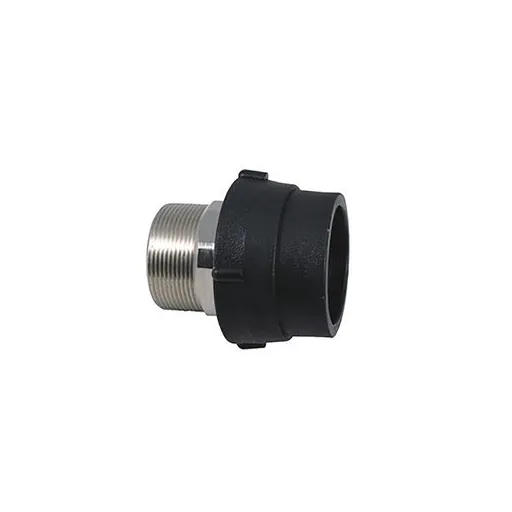
What is Socket Fusion?
Socket fusion welding is an exceptionally reliable thermoplastic welding process for plastic joining. A specially designed socket fusion tool heats the exterior surface of the pipe and the interior surface of the fitting until both reach the molten stage. The components are then pressed together upon adequate heating and left to cool to form a very strong, homogeneous weld. This represents a very smooth transition, thereby not giving room for leaking and increasing the strength of the piping system.
The basic socket-fusion process joins materials such as high-density polyethylene (HDPE), polypropylene (PP), or cross-linked polyethylene (PEX), forming strong, permanent joints without adhesives or mechanical fastening. Due to its high precision and reliability, it finds applications where it is critical in water distribution, gas transmission, and chemical pipeline-processing industries.
Being adhering to standard operating procedures and proper equipment calibration, socket fusion maneuvers well even when subjected to high pressure and temperature variations in working conditions. The success lies with strict adherence to temperature settings, heating time, and alignment of the parts to be fused. From advancements in technology to established standards, socket fusion continues to be an elite choice for constructing piping networks that are durable and leak-proof.
Benefits of Socket Fusion in HDPE Pipe Installation
Strong Leakproof Joints
Socket fusion produces homogeneous joints by melting together and fusing the pipe and fitting materials. The seal thus formed is as strong as the pipe itself, addressing concerns over additional leak points that are usually attached to mechanical joints and hence reducing system failure.
Higher Resistance and Durability
The fused connections offer better resistance when subjected to extreme conditions, situations involving pressures, variations in temperature, and even chemical aggression. For example, socket fusion joints of HDPE can stand pressures up to the order of 200 psi operating pressures and temperatures ranging from -40°F to 140°F, thus making them suitable for various industrial applications.
Corrosion-Resistant
Unlike metallic piping systems, these HDPE pipes and socket fusion joints are immune to corrosion caused by water or soil chemicals. This directly results in a longer service life of the pipe, more than 50 years in most cases, with minimal requirements for maintenance.
Installation into Confined Spaces
Especially helpful is socket fusion when working in trenches or any other environment where installation within limited spaces is needed. It is due to the initiative of having the small and portable equipment for socket fusion that one may be able to carry out precision work in areas that are inappropriate for the use of bigger machines or other methods.
Low Maintenance Costs and Longevity
The butt weld comprises a smooth and continuous surface; hence, the pipe seldom develops any cause for failure. This lowers the maintenance costs of repair over time. Furthermore, the long life of the HDPE piping system makes socket fusion a cheaper option for installation, be it for small or large-scale pipe networks.
Professional Note: Socket Fusion lays strong emphasis on critical performance metrics and on providing long-term value, making it an excellent choice in various industries for HDPE pipe installations.
Socket Fusion Process for Male Threaded Adapters
The socket fusion will require very precise techniques to maintain the strength of the record and avoid leakages. This procedure can be summarized as follows:
Preparation and Inspection
Start by inspecting the HDPE pipe and the male threaded adapters for any defects, possibly cracks or deformations. All components must be clean and free of the slightest speck of dust or grime that could spoil the joining of the fusion. Remove contaminants with an appropriate solvent if necessary.
Cutting and Aligning
The pipe end should be cut squarely with a pipe cutter meant for HDPE materials. Such engraving will assist in maintaining an equal circumference to the pipe or adapter, depending on the joining method. The pipe and adapter should be held straight without offset during fusion.
Heating Phase
The pipe and adapter must be prepared using heating elements suited to the dimensions involved, milled to specifications on a socket fusion tool that has been calibrated for this purpose. The heating tools should be preheated to the temperature specified by the manufacturer, usually between 400–450°F (204–232°C). This very heating operation applies to the outer surface of the pipe and to the inner socket of the adapter until both are sufficiently molten.
Joining and Holding
After they have been heated sufficiently, take the two parts promptly away from the socket fusion tool. Position the male threaded adapter into the pipe socket using a straight motion without twisting. Keep holding constant pressure, ensuring perfect contact of the fusing surfaces. Hold the joint solidly for the whole duration of cooling specified by the manufacturer to obtain a uniform fusion.
Cooling and Inspection
Set the joint down for cooling; do not apply external force or cooling agents. Post-cooling, conduct a visual inspection of the fused connection for any flaws, including bead irregularities or incomplete fusion. Thereafter, conduct a pressure test if necessary to verify the seal’s integrity.
Important: The socket fusion process, if correctly done, will give the HDPE pipe system high mechanical strength and a long life. Adhering to the established industry standards and guidelines, including ASTM F2620, is a must for the highest results and the elimination of any hazards during operations.
Types of HDPE Fittings
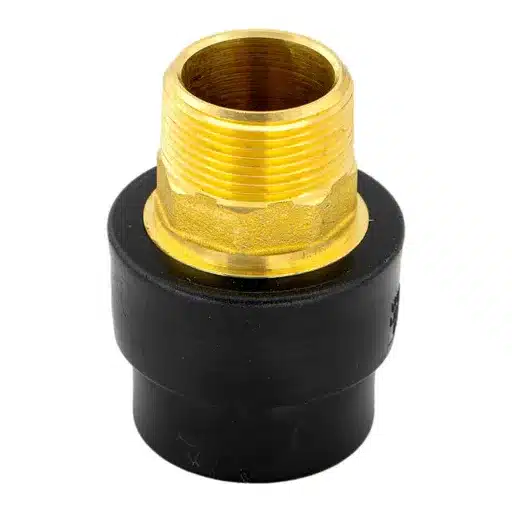
Overview of Different HDPE Pipe Fittings
HDPE pipe systems utilize a wide variety of fittings for their myriad connections, offsets, and adaptations of the system. The major types of HDPE pipe fittings include butt fusion fittings, electrofusion fittings, socket fusion fittings, and mechanical fittings, with each made for different applications and installation methods.
Butt Fusion Fittings
These are used in certain systems where a seamless connection has to withstand high pressure. In butt fusion, one heats the ends of the pipe and fitting and presses them together under pressure to form a weld of homogeneous nature. Its advantages include being an extremely strong joint, resisting leakage, and being ideal for gas and water networks.
Electrofusion Fittings
Built for perfection and reliability, electrofusion fittings have heating elements embedded in them that melt the joining surface of the fitting to the pipe. This method is very handy when making repairs or installations in confined areas, locations where traditional fusion techniques tend to be hard to apply. Nowadays, electrofusion fittings find wide applications in industries demanding high performance and durability.
Socket Fusion Fittings
Commonly chosen for small diameters, socket fusion fittings involve heating the pipe and fitting and inserting the pipe end into the fitting socket to form a secure bond. Used mostly in drainage systems as well as in the distribution of low-pressure fluid, socket fusion fittings facilitate a fast and reliable installation.
Mechanical Fittings
In contrast to fusion techniques, two types of mechanical fittings are compression fittings and threaded fittings. Compression fittings provide a faster way of installation and are well-suited for modular systems or applications where the pipe system may eventually need to be taken apart. Easy to use though they are, mechanical fittings generally tend to leak under extreme pressures-a drawback that fusion fittings do not have.
Professional Insight: Understanding the proper use and operation of HDPE fittings is paramount for selecting suitable ones. When the engineers and technicians adhere to the norms in their specific industry for the material, the jointing method, and the environmental conditions, then the system is considered to be performing at its best, with an extended life.
Comparing Socket vs. Thread Couplings
Socket couplings are welded, for strength and reliability, in high-pressure, high-temperature systems, while threaded couplings are screwed for ease of installation in low-pressure systems.
| Aspect | Socket | Threaded |
|---|---|---|
| Joining Type | Welded | Screwed |
| Durability | High | Moderate |
| Pressure Level | High | Low |
| Heat Tolerance | High | Low |
| Setup Ease | Complex | Easy |
| Upkeep Needs | Low | High |
| Use Cases | Industrial | Domestic |
Specialized HDPE Fittings: Tee, Elbow, and More
This type of specialized HDPE fitting is meant to cater to the precise requirements of intricate piping systems where a conventional coupling might not suffice. Fittings such as tees, elbows, reducers, and end caps are designed to afford flexibility, durability, and efficiency in installation in applications such as water distribution, gas supply, and industrial fluid transportation.
The HDPE Tee Fittings enable pipeline branches so that the flow can be distributed; they exist in an equal or reducing outlet configuration, depending on whether the diameter needs to be stepped down for the branch line. Elbow Fittings let the piping system, HVAC, or industrial fluid piping systems undergo a directional change at 45 degrees or 90 degrees, respectively, helping reduce stress imposed on pipelines due to an almost abrupt change in direction. Both of these fittings are precision-molded to provide resistance to very high pressure and mesh well with the other components.
Additional pipe fittings include reducers to connect pipes of different diameters while maintaining some flow integrity and end caps to seal the pipe ends. These are tough, fitting constructions capable of withstanding harsh environmental and operational conditions. With such improvements as CNC machining and automated molding, HDPE fittings are therefore kept within tight tolerance and conform to international specifications such as ISO 4427 or ASTM F714.
The efficacy of these fittings can be further enhanced when used in integrated designs established using advanced software to analyze pipeline stresses and optimize thermal expansion, thereby making these fittings indispensable in modern infrastructure projects.
Installation Guidelines for HDPE Socket Male Couplers
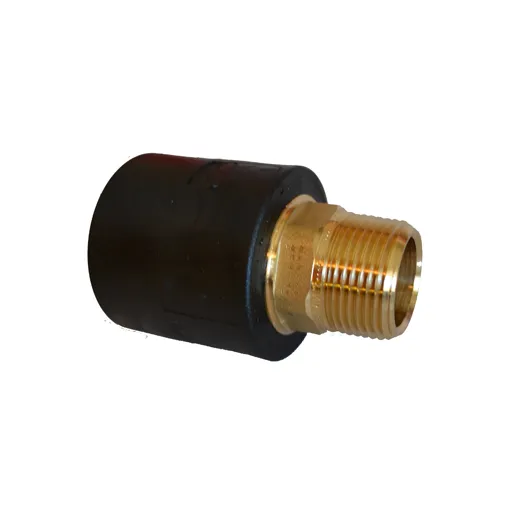
Step-by-Step Installation Process
Material and Tool Preparation
Ensure that all the materials and tools required, including the HDPE socket male coupler, pipe cutter, deburring tool, heating device (if required), and safety equipment, are available. Ensure that the components are devoid of defects and that they are in accordance with the standards like ISO 4427 or ASTM F714.
Pipe Measurement and Cutting
Measure the pipe length according to specifications. Use a pipe cutter to make straight and clean cuts so that the pipe will fit snugly into the socket coupler. Deburr and smooth the outer edges of the cut pipe so as not to injure the coupling surface.
Surface Cleaning
Clean the outer surface of the pipe and the inner surface of the coupler. Cleaning agents must remove dirt, grease, or any other unfitting contaminants that will resist bonding or mechanical connection.
Coupler to Pipe Connections
A pipe shall be inserted into the socket male coupler through steady and even pressure. For fusion methods, the joining elements shall be kept in position until the joint material has fully cooled and solidified to provide proper strength. For mechanical-type joints, tighten the fittings according to the torque specification of the manufacturer.
Post-Installation Inspection
Once the connection has been concluded, it has to be inspected visually and functionally for alignment, leak-proof performance, and strength of bonding. Pressure testers or pressure gauges are some of the tools that can be applied to test if the joint is still intact during operations.
Documentation and Notes for Maintenance
A technical report is to be created, detailing the installation process, materials used, and inspection results, for future reference. The report must include maintenance instructions or inspection intervals, which must be followed in order to sustain a reliable installation.
Quality Assurance: This entire process guarantees a secure, long-lasting, and well-performing connection through the application of high-grade HDPE socket male couplers, necessary for good pipeline activity within modern infrastructure systems.
Tools Required for Installation
Essential tools and equipment for a precise and swift installation of high-quality HDPE socket male couplers are:
Pipe Cutter
Without such a lance, one cannot execute a clean cut and an accurate length cut of the HDPE pipes for proper coupling.
Deburring Tool
To remove burrs and contaminants at the edges of the pipe ends, these is necessary to ensure a proper interface.
Torque Wrench
Provides the correct amount of torque when tightening the couplers, which is very important as over-tightening ruins material integrity.
Caliper or Measuring Tape
To ensure the pipe and the coupler are measured for fitting purposes.
Pipe Support Clamps
To hold pipes steady and stabilize them during installation.
Industrial-Grade Heat Gun
If the fitting requires heating, this will assist with expanding or softening the piping ends for better coupling.
Thread Seal Tape
For an extra layer of sealant for threaded couplers to secure leak-free joints.
Personal Protective Equipment
Safety gloves and goggles are included for protection against abrasions from small rocks or pebbles, debris, and chemicals.
Safety First: Each tool is carefully chosen for its critical function in maintaining the structure and operational viability of HDPE coupler installations. The proper use of these tools will guarantee the precise assembly process while maintaining equipment safety standards.
Common Installation Mistakes to Avoid
❌ Incorrect Alignment of Couplers
Any distortion in the coupling will ensure the loss of integrity of the joint. Therefore, the two ends of the HDPE must be properly aligned before the insertion of the coupler so that stress points or even leaks do not develop.
❌ Over-Tightening of Threaded Connections
Excessive pressure applied in tightening can easily destroy threads or distort the walls of the coupler. Always follow the torque values as specified by the manufacturer.
❌ Insufficient Pipe Surface Preparation
Not cleaning or making the pipe surface smooth enough before installation will ensure a faulty connection. Dirt, grease, or any debris must be stripped away completely so a proper seal can be achieved.
❌ Neglecting Temperature Considerations
HDPE couplers can be installed in extreme temperatures, but failures could occur if one does not consider the expansion or contraction of the joint on that basis. Operators must follow recommendations on temperature ranges and take into account material behavior at the application site.
❌ Using Unsuitable Tools
Employing inappropriate or non-recommended tools can cause physical damage to the coupler or pipe, potentially leading to a failed installation. Always utilize tools that meet industry standards and are designed specifically for HDPE materials.
❌ Ignoring Manufacturer Guidelines
Skipping or misinterpreting procedural instructions can compromise both the performance and safety of the installation. It is imperative to follow every aspect of the manufacturer’s installation guide, from preparation to assembly.
Best Practice: Changes in these common things, plus the use of best practices, assure the installers of a coupling system with common performance, secure, durable, and with a lifetime.
Advancements in HDPE Technology
Innovations in HDPE Fittings
HDPE fittings revolutionized modern piping systems with regard to strength, versatility, and environmental compatibility. Among the more novel modifications would be their electrofusion and butt fusion techniques for making seamless joints that are leak-proof; so least maintenance is necessary, thus enhancing reliability. Besides, the suppliers are striving to impart high-pressure resistance to HDPE fittings so that they can withstand more demanding applications like industrial and high-capacity water distribution systems.
Also notable is the smart-monitoring capability. For instance, embedded fitting sensors can now monitor flow rates, temperature changes, or even leaks in real time to better manage systems. On the other hand, the use of newer polymer formulations ensured that HDPE fittings come with better chemical and UV resistance, making them suitable for harsh environments and chemical-intensive industries.
Lastly, in response to the call for sustainable solutions, some researchers successfully produced recyclable and green HDPE materials. These improvements go with the current trends in industry that focus on long-term performance with reduced environmental impact and at a lower cost through their entire lifecycle. The offered technological advancements not only increase the application possibilities of HDPE fittings but also optimize them to serve infrastructural changes with increasingly complex demands.
Future Trends in Pipe Fusion Technology
Integration of high-level automation, microscale precision engineering, and digital tools will mark the advent of an era of pipe fusion technology in which installation procedures will be simplified to ensure superior joint integrity. One major trend is the prevalent use of automated fusion machines having smart sensors and IoT connectivity. Parameters such as temperature, pressure, and fusion time are continuously being monitored to meet the stringent standards imposed by industries, thereby resulting in almost zero joint failures.
The other developments with thermoplastic materials are presenting high-performance pipes capable of withstanding extremely adverse environmental conditions and chemical exposures. Fusion-compatible advanced polymer can also ensure the strength and durability of these pipes, thereby broadening the scope of application of these pipe systems into the energy, mining, and water management sectors.
The inclusion of data-driven technologies is shifting the industry. For example, operators have now been provided with cloud-based platforms that log and analyze fusion data, providing unmatched transparency and traceability during the installation process. These platforms could facilitate predictive maintenance by detecting patterns or anomalies that may degrade system reliability with time.
Sustainability, on the other hand, is carving out a more prominent position in sculpting the evolution of pipe fusion technologies. Manufacturers are developing new recyclable thermoplastics and energy-efficient solution fusion equipment that minimizes waste and environmental emissions during the installation process. These innovations are aligned with global endeavors to produce infrastructure that is not only affordable and environmentally responsible, thus setting the stage for continual evolution in the field.
Impact of New Materials in HDPE Coupling
In my eyes, the introduction of new materials in the field of HDPE coupling has posed a major change in this trade. The use of advanced material formulations has enhanced the HDPE couplings in durability, flexibility, and chemical resistance so that they can be offered on a larger scale for applications. These new materials can withstand the harshest temperatures and corrosive environments while being light in weight, thereby solving problems for oil and gas, water distribution, and agriculture sectors.
In addition, the further development of composite materials with better mechanical properties has resulted in better joint integrity, whereas the chance of failures occurring over time has reduced. By incorporating these technologies into HDPE coupling systems, manufacturers have been able to extend the service life of infrastructure while simultaneously reducing maintenance costs. This is especially relevant in ensuring reliability in critical systems, where it is an absolute requirement for performance consistency.
Finally, the sustainability of these new materials is something that cannot be understated. Many of the developments are expressly designed to be environmentally friendly, with a focus on recyclable compounds, a lesser energy requirement in production, and fusion processes. The essence of global sustainable development not only addresses environmental issues but also strongly strengthens the case for these materials to be introduced into modern infrastructure projects. From my analysis, it is apparent that the developments will further challenge what HDPE coupling can do to increase efficiency, life, and sustainability.
Frequently Asked Questions (FAQ)
Q: What is an HDPE socket male coupler?
A: An HDPE socket male coupler is a fitting used for coupling two lengths of HDPE pipe or to couple an HDPE pipe with a fitting that comes with a female thread. It has a socket end that can be joined by HDPE socket fusions, creating a very strong and durable joint.
Q: How does HDPE socket fusion work?
A: This fusion process involves heating the two pieces of HDPE and fusing them to form a permanent bond. This method is commonly applied to HDPE socket male couplers to provide leak-proof connections in water distribution systems, withstanding pressure and environmental stress.
Q: Can I use HDPE socket male couplers with PE80 and PE100 pipes?
A: Yes, HDPE socket male couplers can be used with PE80 and PE100 pipes. These couplers are designed to be connected to any grade of polyethylene pipes to provide a reliable connection for a variety of applications.
Q: What are the advantages of using HDPE male threaded adaptors?
A: HDPE male threaded adaptors have many advantages: they can connect to male-female fittings, are easy to install, and can be used with almost all pipe systems. They are made from high-quality virgin PE100 material, so they are highly durable and resistant to chemicals and corrosion.
Q: Are HDPE socket male couplers appropriate for high-pressure water pipe systems?
A: Yes. HDPE socket male couplers are suitable for high-pressure applications. When installed by socket fusion or by the use of an alternative fitting such as a PP compression fitting, they can withstand high pressure and are thus very suitable for water pipe systems.
Q: What are the HDPE male coupling sizes?
A: HDPE male couplings come in many sizes, usually from 20mm up to 110mm, to fit pipes of various diameters. This range of choices assures you of finding the correct coupling for your project requirements.
Q: How do I make sure that the HDPE socket fittings I acquire are of good quality?
A: The quality of HDPE socket fittings depends largely on proper sourcing from a reputable manufacturer with stringent quality control processes. Fittings made from virgin PE100 material should be preferred as these will generally have better performance and longevity.
Q: How is an HDPE male coupling different from the socket fusion male threaded adapter?
A: An HDPE male coupling is a fitting used to connect two pipes directly, whereas a socket fusion male threaded adapter has threads to be connected to a threaded fitting. The latter comes in handy in a situation where you would like to go between two kinds of connections, such as from a socket fusion to a threaded fitting.
Q: Can HDPE socket male couplers be used for outdoor applications?
A: Yes, HDPE socket male couplers can be utilized outdoors because of their superior resistance to UV rays and other environmental conditions. They are commonly used in irrigation systems and other types of outdoor plumbing, wherein the connection needs to be made long-lasting and dependable.
References
- MIT DSPACE: Along with research on socket designs and materials like HDPE, it is an academic research repository.
- Academia.edu: Platform for academic papers, including papers on prosthetic socket designs and HDPE applications.
- Virginia Tech VTechWorks: Research on biomimetic designs and material coupling, including HDPE composites.
Professional Installation Services
For optimal performance and longevity of your HDPE socket male coupler installations, consider consulting with certified professionals who follow industry standards and best practices.



